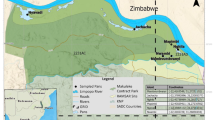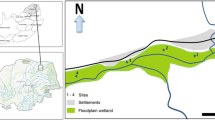Abstract
To investigate potential high organisational level impacts of persistent organic pollution in the wetlands in the Sydney Olympic Park (SOP) remediated site, the benthic macroinvertebrate assemblages of seven wetlands within SOP and two off-site reference wetlands were examined. Sediment cores were collected, stained and preserved from each study site and the macroinvertebrates identified to the appropriate taxonomic level (Class, Order, Family, Subfamily). Data were analysed for taxon richness and macroinvertebrate abundance and multivariate techniques were used to identify chemical/physical characteristics of the sediment, which were important influences on the differences in the assemblage between study sites. Macroinvertebrate abundance was highly variable between study sites and taxon richness was low across all sites. Oligochaetes, nematodes, ostracods and chironomids were the most common taxa found and were the most important in influencing differences between the macroinvertebrate assemblages among the study sites. Sediment grain size and chemical characteristics of the sediments (ΣPAH, ΣPCB, TCDDeq and heavy metal concentrations) were important in separating the study sites based on taxon richness and abundance. Canonical correspondence analysis separated the macroinvertebrate assemblages at newly two created wetlands from those at other study sites including the urban reference sites. Increased sediment POP contamination (particularly as measured TCDDeq and ΣDDT concentrations) is a likely contributor in excluding pollution sensitive taxa and, therefore, alterations to benthic macroinvertebrate assemblages. Further, the influence of TOC suggests the significance of catchment inputs in contributing to changes in macroinvertebrate assemblage. The SOP remediation led to the establishment of wetlands with benthic communities representative of those expected in urban wetlands.






Similar content being viewed by others
References
Achman DR, Brownawell BJ, Zhang L (1996) Exchange of polychlorinated biphenyls between sediment and water in the Hudson River estuary. Estuaries 19:950–965
Boese BL, Lamberson JO, Swartz RC, Ozretich RJ, Cole FA (1998) Photoinduced toxicity of PAHs and alkylated PAHs to a marine infaunal amphipod (Rhepoxynius abronius). Arch Environ Contam Toxicol 34:235–240
Boulton AJ, Peterson CG, Grimm NB, Fisher SG (1992) Stability of an aquatic macroinvertebrate community in a multiyear hydrologic disturbance regime. Ecology 73:2192–2207
Burt AJ, McKee PM, Hart DR, Kauss PB (1991) Effects of pollution in benthic invertebrate communities of the St Marys River, 1985. Hydrobiologia 219:63–81
den Besten PJ, van den Brink PJ (2005) Bioassay responses and effects on benthos after pilot remediations in the delta of the rivers Rhine and Meuse. Environ Pollut 136:197–208
Downes BJ, Lake PS, Schreiber ESG (1993) Spatial variation in the distribution of stream invertebrates: implications of patchiness for models of community organisation. Freshwater Biol 30:119–132
Feng H, Cochran JK, Lwiza H, Brownawell BJ, Hirschberg DJ (1998) Distribution of heavy metal and PCB contaminants in the sediments of an urban estuary: the Hudson River. Mar Environ Res 45:69–88
Froese KL, Verbrugge DA, Ankley GT, Niemi GJ, Larsen CP, Giesy JP (1998) Bioaccumulation of polychlorinated biphenyls from sediments to aquatic insects and tree swallow eggs and nestlings in Saginaw Bay, Michigan. USA Environ Toxicol Chem 17:484–492
Gooderham J, Tsyrlin E (2002) The Waterbug book: a guide to the freshwater macroinvertebrates of temperate Australia. CSIRO Publishing, Collingwood, Australia
Gustafsson O, Haghseta F, Chan C, Macfarlane J, Gschwend PM (1997) Quantification of the dilute sedimentary soot phase: implications for PAH speciation and bioavailability. Environ Sci Technol 31:203–209
Hall MJ, Closs GP, Riley RH (2001) Relationships between land use and stream invertebrates community structure in a South Island, New Zealand, coastal stream catchment. New Zeal J Mar Fresh 35:591–603
Heino J, Louhi P, Muotka T (2004) Identifying the scales of variability in stream macroinvertebrate abundance, functional composition and assemblage structure. Freshwater Biol 49:1230–1239
Hickey CW, Clements WH (1998) Effects of heavy metals on benthic macroinvertebrate communities in New Zealand streams. Environ Toxicol Chem 17:2338–2346
Hirst H, Juttner I, Omerod SJ (2002) Comparing the responses of diatoms and macroinvertebrates to metals in upland streams of Wales and Cornwall. Freshwater Biol 47:1752–1765
Hodkinson ID, Jackson JK (2005) Terrestrial and aquatic invertebrates as bioindicators for environmental monitoring with particular reference to mountain ecosystems. Environ Manage 35:649–666
Hoffman EJ, Mills GL, Latimer JS, Quinn JG (1984) Urban runoff as a source of polycyclic aromatic hydrocarbons to coastal waters. Environ Sci Technol 18:580–587
Hwang H, Fisher SW, Kim K, Landrum PF (2004) Comparison of the toxicity using body residues of DDE and select PCB congeners to the midge Chironomus riparans, in partial life cycle tests. Arch Environ Contam Toxicol 46:32–42
Johnson AC, Larsen PF (1985) The distribution of polycyclic aromatic hydrocarbons in the surficial sediments of Penobscot Bay (Maine, USA) in relation to possible sources and to other sites worldwide. Mar Environ Res 15:1–16
Koh C-H, Khim JS, Kannan K, Villeneuve DL, Senthilkumar K, Giesy JP (2004) Polychlorinated dibenzo-p-dioxins (PCDDs), dibenzofurans (PCDFs), biphenyls (PCBs), and polycyclic aromatic hydrocarbons (PAHs) and 2,3,7,8-TCDD equivalents (TEQs) in sediment from the Hyeongsan River. Korea Environ Pollut 132:489–501
Laginestra E, Slattery E, Statzenko A (2001) Sydney olympic park: post remediation reference manual, 2001. Sydney Olympic Park Authority (SOPA), Sydney, Australia
LeFevre SR, Sharpe WE (2002) Acid stream water remediation using limestone sand on Bear Run in southwestern Pennsylvania. Restor Ecol 10:223–236
Lenat DR, Crawford JK (1994) Effects of land use on water quality and aquatic biota of three North Carolina Piedmont streams. Hydrobiologia 294:185–199
Lotufo GR (1998a) Bioaccumulation of sediment associated fluoranthene in benthic copepods: uptake, elimination and biotransformation. Aquat Toxicol 44:1–15
Lotufo GR (1998b) Lethal and sublethal toxicity of sediment-associated fluoranthene to benthic copepods: application of the critical-body-residue approach. Aquat Toxicol 44:17–30
Magnusson K, Ekelund R, Grabic R, Bergquist P-A (2006) Bioaccumulation of PCB congeners in marine benthic infauna. Mar Environ Res 61:379–395
Mayer FL, Mehrle PM, Sanders HO (1977) Residue dynamics and biological effects of polychlorinated biphenyls in aquatic organisms. Arch Environ Contam Toxicol 5:501–511
Neely WB, Branson DR, Blau GE (1974) Partition coefficient to measure bioconcentration potential of organic chemicals in fish. Environ Sci Technol 8:1113–1115
Nelson SM, Roline RA (1996) Recovery of a stream macroinvertebrate community from main drainage disturbance. Hydrobiologia 339:73–84
Niemi GJ, DeVore P, Detenbeck N, Taylor D, Lima A, Pastor J (1990) Overview of case studies on recovery of aquatic systems from disturbance. Environ Manage 14:571–587
Persson NJ, Bucheli TD, Gustafsson O, Broman D, Naes K, Ishaq R, Zebuhr Y (2005) Testing common sediment-porewater distribution models for their ability to predict dissolved concentrations of POPs in the Grenlandsfjords, Norway. Chemosphere 59:1475–1485
Phipps GL, Mattson VR, Ankley GT (1995) Relative sensitivity of three freshwater benthic macroinvertebrates to ten contaminants. Arch Environ Contam Toxicol 28:281–286
Pratt JR, Coler RA, Godfrey PJ (1981) Ecological effects of urban stormwater runoff on benthic macroinvertebrates inhabiting the Green River, Massachusetts. Hydrobiologia 83:29–42
Quinn JM, Hickey CW (1990) Characterisation of benthic invertebrate communities in 88 New Zealand rivers in relation to environmental factors. New Zeal J Mar Fresh 24:387–409
Rawson CA, Tremblay LA, Warne MSJ, Kookana RS, Ying G-G, Chapman JC, Lim RP (2009) Bioactivity of POPs and their effects in mosquitofish in Sydney Olympic Park, Australia. Sci Total Environ 407:3721–3730
Resh VH, McElvray EP (1993) Contemporary quantitative approaches to biomonitoring using benthic macroinvertebrates. In: Rosenberg DM, Resh VH (eds) Freshwater biomonitoring and benthic macroinvertebrates. Routledge, Chapman and Hall, New York, pp 159–194
Reynoldson TB (1987) Interactions between sediments and contaminants and benthic organisms. Hydrobiologia 149:53–66
Sandin L, Johnson RK (2000) The statistical power of selected indicator metrics using macroinvertebrates for assessing acidification and eutrophication of running waters. Hydrobiologia 422(423):233–243
Schrock ME, Barrows ES, Rosman LB (1997) Biota-to-sediment accumulation factors for TCDD and TCDF in worms from a 28-day bioaccumulation test. Chemosphere 34:1333–1339
Shutes RBE (1984) The influence of surface runoff on the macro-invertebrate fauna of an urban stream. Sci Total Environ 33:271–282
Simon ML, Cherry DS, Currie RJ, Zipper CE (2006) The ecotoxicological recovery of Ely Creek and tributaries (Lee County, VA) after remediation of acid mine drainage. Environ Monit Assess 123:109–124
Stark JS, Snape I, Riddle MJ, Stark SC (2005) Constrains on spatial variability on soft-sediment communities affected by contamination from an Antarctic waste disposal site. Mar Pollut Bull 50:276–290
Stenroth P, Nystrom P (2003) Exotic crayfish in a brown water stream: effects on juvenile trout, invertebrates and algae. Freshwater Biol 48:466–475
Swartz RC, Kemp PF, Schults DW, Ditsworth GR, Ozretich RJ (1989) Acute toxicity of sediment from Eagle Harbour, Washington, to the infaunal amphipod Rhepoxynius abronius. Environ Toxicol Chem 8:215–222
Thoman RV, Komlos J (1999) Model of biota-sediment accumulation factor for polycyclic aromatic hydrocarbons. Environ Toxicol Chem 18:1060–1068
Timmermann K, Andersen O (2003) Bioavailability of pyrene to the deposit-feeding polychaete Arenicola marina: importance of sediment versus water uptake routes. Mar Ecol-Prog Ser 246:163–172
Wallace JB, Grubauch JW, Whiles MR (1996) Biotic indices and stream ecosystem processes: results from an experimental study. Ecol Appl 6:140–151
West CW, Ankley GT, Nichols JW, Elonen GE, Nessa DE (1997) Toxicity and bioaccumulation of 2,3,7,8-tetrachlorodibenzo-p-dioxin in long-term tests with the freshwater benthic invertebrates Chironomus tentans and Lumbricus variegatus. Environ Toxicol Chem 16:1287–1294
Whiting ER, Clifford HF (1983) Invertebrates and urban runoff in a small northern stream, Edmonton, Alberta, Canada. Hydrobiologia 102:73–80
Williams WD (1980) Australian freshwater life: the invertebrates of Australian Inland waters. Macmillan Publishers Australia, South Yarra, Australia
Ying G-G, Rawson C, Kookana RS, Lim RP, Warne MSJ, Zhou J-L, Peng P-A, Li X-M, Laginestra E (2009) Distribution and sources of inorganic and organic contaminants in sediments from Sydney Olympic Park and the surrounding Sydney metropolitan area. J Environ Monit 11:1687–1696
Acknowledgments
This research was funded by an Australian Research Council (ARC) Linkage Grant (LP0455131) awarded to UTS.
Author information
Authors and Affiliations
Corresponding author
Rights and permissions
About this article
Cite this article
Rawson, C.A., Lim, R.P., Tremblay, L.A. et al. Benthic macroinvertebrate assemblages in remediated wetlands around Sydney, Australia. Ecotoxicology 19, 1589–1600 (2010). https://doi.org/10.1007/s10646-010-0544-6
Accepted:
Published:
Issue Date:
DOI: https://doi.org/10.1007/s10646-010-0544-6




